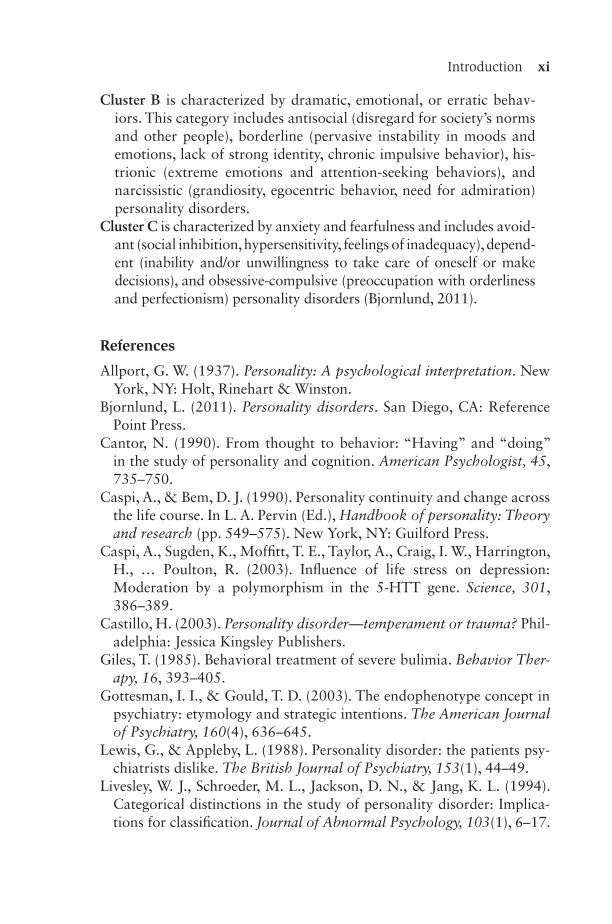Introduction xi Cluster B is characterized by dramatic, emotional, or erratic behav- iors. This category includes antisocial (disregard for society’s norms and other people), borderline (pervasive instability in moods and emotions, lack of strong identity, chronic impulsive behavior), his- trionic (extreme emotions and attention-seeking behaviors), and narcissistic (grandiosity, egocentric behavior, need for admiration) personality disorders. Cluster C is characterized by anxiety and fearfulness and includes avoid- ant (social inhibition, hypersensitivity, feelings of inadequacy), depend- ent (inability and/or unwillingness to take care of oneself or make decisions), and obsessive-compulsive (preoccupation with orderliness and perfectionism) personality disorders (Bjornlund, 2011). References Allport, G. W. (1937). Personality: A psychological interpretation. New York, NY: Holt, Rinehart & Winston. Bjornlund, L. (2011). Personality disorders. San Diego, CA: Reference Point Press. Cantor, N. (1990). From thought to behavior: “Having” and “doing” in the study of personality and cognition. American Psychologist, 45, 735–750. Caspi, A., & Bem, D. J. (1990). Personality continuity and change across the life course. In L. A. Pervin (Ed.), Handbook of personality: Theory and research (pp. 549–575). New York, NY: Guilford Press. Caspi, A., Sugden, K., Moffitt, T. E., Taylor, A., Craig, I. W., Harrington, H., … Poulton, R. (2003). Influence of life stress on depression: Moderation by a polymorphism in the 5-HTT gene. Science, 301, 386–389. Castillo, H. (2003). Personality disorder—temperament or trauma? Phil- adelphia: Jessica Kingsley Publishers. Giles, T. (1985). Behavioral treatment of severe bulimia. Behavior Ther- apy, 16, 393–405. Gottesman, I. I., & Gould, T. D. (2003). The endophenotype concept in psychiatry: etymology and strategic intentions. The American Journal of Psychiatry, 160(4), 636–645. Lewis, G., & Appleby, L. (1988). Personality disorder: the patients psy- chiatrists dislike. The British Journal of Psychiatry, 153(1), 44–49. Livesley, W. J., Schroeder, M. L., Jackson, D. N., & Jang, K. L. (1994). Categorical distinctions in the study of personality disorder: Implica- tions for classification. Journal of Abnormal Psychology, 103(1), 6–17.
Document Details My Account Print multiple pages
Print
You have printed 0 times in the last 24 hours.
Your print count will reset on at .
You may print 0 more time(s) before then.
You may print a maximum of 0 pages at a time.


























































































































































































































































